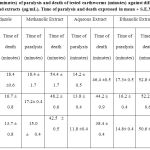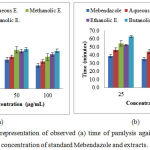Trupti P. Durgawale1 , Chitra C. Khanwelkar2
, Chitra C. Khanwelkar2 , Pratik P. Durgawale3 and Satish V. Kakade4
, Pratik P. Durgawale3 and Satish V. Kakade4
1Department of Pharmacology, Krishna Institute of Medical Sciences Deemed University (KIMSDU), Karad, Maharashtra, India.
2Department of Pharmacology, Krishna Institute of Medical Sciences Deemed University (KIMSDU), Karad, Maharashtra, India.
3Genetic and Molecular Laboratory, Krishna Institute of Medical Sciences Deemed University (KIMSDU), Karad, Maharashtra, India.
4Department of Community Medicine, Krishna Institute of Medical Sciences Deemed University (KIMSDU), Karad, Maharashtra, India.
Corresponding Author E-mail: truptipdurgawale@gmail.com
DOI : https://dx.doi.org/10.13005/bpj/1322
Abstract
Parasitic diseases, especially, helmenthiasis pose a threat to human health and livestock alike. This imposes a greater burden of health care expenditure in tropical countries where these are endemic. Recently, the research for naturally- derived anthelmintics has been encouraged. Portulaca olarecea, commonly called as Purslane, has been part of diet in Asian and Mediterranean region. In the present study, various extracts of Purslane were tested for their anthelmintic activity on Indian adult earthworms (Pheretima posthuma). The anthelmintic activity of all the extracts was concentration- dependent and comparable to that of standard; while aqueous extract exhibited greatest activity. Further in- vivo tests and phytochemical research would shed light on potential activities of Purslane.
Keywords
Anthelmintic; Portulaca Olarecea;Pheretima posthuma
Download this article as:| Copy the following to cite this article: Durgawale T. P, Khanwelkar C. C, Durgawale P. P, Kakade S. V. Comparative Anthelmintic Activity of Different Extracts of Portulaca Oleraceae L.Whole Plant. Biomed Pharmacol J 2017;10(4). |
| Copy the following to cite this URL: Durgawale T. P, Khanwelkar C. C, Durgawale P. P, Kakade S. V. Comparative Anthelmintic Activity of Different Extracts of Portulaca Oleraceae L.Whole Plant. Biomed Pharmacol J 2017;10(4). Available from: http://biomedpharmajournal.org/?p=17833 |
Introduction
Infections by helminthes are a major cause of concern for human health and cattle. Larvae of helminthes predominantly exist in the intestinal tract leading to malnutrition, pneumonia, eosinophilia and anemia.1 Other clinical manifestations include dysentery, dermatological disorders, loss of appetite and loss of body weight. Cases of presence of eggs or larvae in other tissues in the body have also been reported.1-2 Parasitic diseases, especially, helmenthiasis are more common in the tropical countries including Asian countries and are endemic in nature.3 Repeated and unregulated use of chemical anthelmintic drugs over considerable years has resulted in resistance amongst helminthes to these drugs. As a result, discovery of novel anthelmintic drug candidates is of prime importance to minimize the damage caused by helminthes.2 Owing to the general observations, naturally derived drug candidates have fewer side effects as compared to their chemically synthesized counterparts. This has lead to pharmacognostic investigations of anthelmictic activity of plant- derived products in recent years. As a primary requirement for such study, the plant candidate should be a part of accepted diet. One such potential plant candidate could be Portulaca olarecea, commonly called as Purslane.
Purslane is a common weed in field crops and turfgrass found in countries of Asia and Europe.4 In parts of central Europe and Mediterranean regions it is also grown as a potherb and used in salad. As an ethnomedicinal plant, it has been used for treatment of burns, headaches, ailments related to intestine, stomach, and arthritis.4 Purslane has been reported to contain many bioactive compounds such as flavanoids, alkaloids, coumarins, anthraquinones, catechol, saponoins and tannins.5 In the present study, we investigated the anthelmintic activity of different extracts of Purslane whole plant, in comparison to a standard.
Materials and Methods
Plant Material
Fresh whole plant (weed) of Portulaca oleraceae was collected from our garden and authenticated by Dr. Dhanaji S. Pawar, Associate Professor, Department of Botany, M. H. Shinde Mahavidylaya, Tisangi.
Drugs and Chemicals
Mebendazole Suspensioin (Cipla), ethanol, methanol, butanol, carboxymethyl cellulose (CMC), all chemicals used were laboratory and analytical grade.
Preparation of Plant Extract
The fresh whole weed of Portulaca oleraceae was washed with distilled water and cut into small pieces. Then 250 gram (g) weed of Portulaca oleraceae was extracted with 800 millitre (ml) analytical grade ethanol in soxhlet apparatus and extracted repeatedly for 48 hrs. The same procedure of extraction was followed using methanol and butanol solvents, separately. These three different extracts were dried by solvent evaporation in thermostat water bath at 50-60 0C temperature.
Another 250 g of weed of Portulaca oleraceae was macerated with 800 ml distilled water for 48 hours (hrs) .After completion of 48 hrs it was filtered to separate water extract from the marc. The extract was concentrated in themostat water bath at 50-60 0C temperature and all the extracts were kept in desiccator for the experiment.
Selection of Experimental Model
Indian adult earthworms (Pheretima posthuma) were used during the experiment. The earthworms were collected from a local supplier. Worms were washed with normal saline to remove all fecal matter .The earthworms of 8-10 centimeter (cm) in length and 0.2 -0.5 cm width were used for all the experiment protocol. Ready availability, anatomical and physiological resemblance of (Pheretima posthuma) made it to be used initially for in-vitro evaluation of anthelmintic activity. Time for paralysis was noted either when any movement could not be observed except when the worms where shaken vigorously. Death was included when the worms lost their motility followed by white secretions and fading away of their body colour.
Results and Discussion
The Indian earthworms (Pheretima posthuma) of nearly equal size, six in each group was taken for experiment. Four different extracts were suspended in 1% (w/v) CMC suspension prepared in normal saline water in three different concentrations.
 |
Table 1: Recorded time (minutes) of paralysis and death of tested earthworms (minutes) against different concentrations of standard Mebendazole and extracts (µg/mL). Time of paralysis and death expressed in mean + S.E.M.
|
At various concentration 25, 50,100 µg/mL comparison of time of paralysis using standard Mebendazole and various extracts showed significant difference ( F = 6.751, F = 18.117, F = 13.888 for all F, p<0.001). However, Tukey Kramer multiple comparison test, the post- hoc test revealed that time of paralysis observed using Mebendazole and aqueous extract was similar at all studied concentrations.
Similarly, at various concentrations 25, 50, 100 µg/mL comparison of time of death using standard Mebendazole and various extracts showed significant difference ( F = 258.33, F = 333.48, F = 460.06 for all F, p<0.001). However, Tukey Kramer test did not show similar time taken by any studied extract in comparison to standard Mebendazole.
 |
Figure 1: Graphical representation of observed (a) time of paralysis against concentration; (b) time of death against concentration of standard Mebendazole and extracts.
|
All the extracts exhibit concentration- dependent activity [Table 1, Fig 1]. As can be observed from the results, amongst the extracts of Portulaca oleraceae the aqueous extract exhibited the most anthelmintic activity with the least time required to paralyse and completely kill the earthworms at every tested concentration. Anthelmintic activity potency of the aqueous extract was followed by ethanolic, methanolic and butanolic extracts, respectively.
In a similar previously reported study, where the anthelmintic activity of different various extracts of Euphorbia thymifolia were tested on Pheretima posthuma and Ascaria galli worms, anthelmintic acitivity was observed in both aqueous and methanolic extract.6 In another study, where anthelmitic activity of different extracts of Enicostemma littorale were studied, it was observed that ethanolic extract had greater paralytic activity over ethyl acetate, aqueous, chloroform, and hexane extracts.7 The anthelmintic activity of Luffa cylindrica leaves extract was observed for both aqueous and methanolic extracts against P. posthuma.2 Most of the research groups have estimated that the greater amount of polyphenolics in their respective alcoholic extracts may be responsible for the observed anthelmintic activity.
Conclusion
After applying the Tukey Kramer multiple comparison test for the observed values, it can be concluded that the aqueous extract of Portulaca oleraceae exhibited anthelmintic activity similar to the standard Mebendazole with respect to time of paralysis at the tested concentrations. In order to further investigate the anthelmintic potential of this extract, phytochemical analysis and in- vivo tests may be undertaken.
Acknowlegement
The authors would like to extend their gratitude towards the Directorate of Research, KIMSDU, for supporting this research and providing all the facilities required.
Funding Source
All facilities and financial resources were provided by KIMSDU and no external funding was involved.
Conflict of Interest
The authors would like to declare no conflict of interest financially or personally with any other person or organization.
References
- Kosalge S.B and Fursule R.A. Investigation of in vitro anthelmintic activity of Thespesia lampas (Cav.). Asian Journal of Pharmaceutical and Clinical Research. 2009;2(2):69-71.
- Kumar A, Sangh P, Sharma N.K. Phytochemical, ethnobotanical and pharmacological profile of Lagenaria siceraria:-A review. Journal of Pharmacognosy and Phytochemistry. 2012;1.3.
- Pullan R L, Smith J.L, Jasrasaria R & Brooker S.J. Global numbers of infection and disease burden of soil transmitted helminth infections in 2010. Parasites & vectors. 2014;7(1):37.
CrossRef - Rasheed A. N, Afifi F.U, Shaedah M & Taha M.O. Investigation of the active constituents of Portulaca oleraceae L. (Portulacaceae) growing in Jordan. Pak J Pharm Sci. 2004;17(1):37-45.
- Uddin M.K, Juraimi A. S, Hossain M.S, Nahar M. A.U, Ali M. E & Rahman M.M. Purslane weed (Portulaca oleracea): a prospective plant source of nutrition, omega-3 fatty acid, and antioxidant attributes. The Scientific World Journal. 2014;2014.
- Kane S.R, Mohite S.K & Shete J.S. Antihelmintic activity of aqueous and methanolic extracts of. Euphorbia thymifolia linn.Int J Pharm Tech Res. 2009;1:666-669.
- Vidyadhar S, Saidulu M, Gopal T.K, Chamundeeswari D, Rao U & Banji D. In vitro anthelmintic activity of the whole plant of Enicostemma littorale by using various extracts. International Journal of Applied Biology and Pharmaceutical Technology. 2010;1(3):1119-1125.








